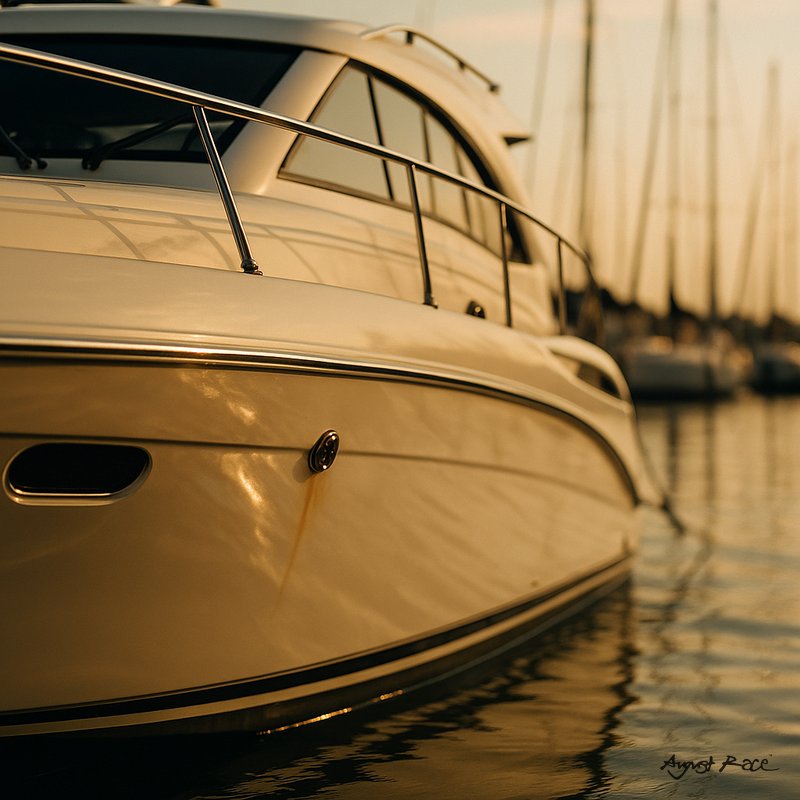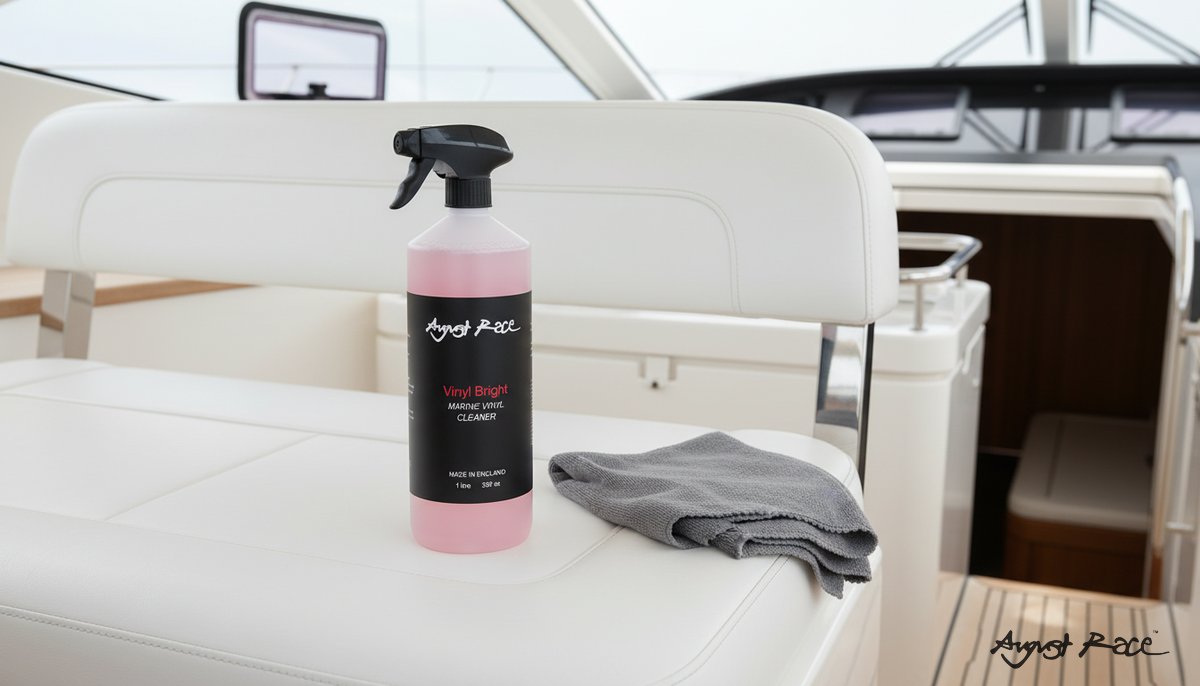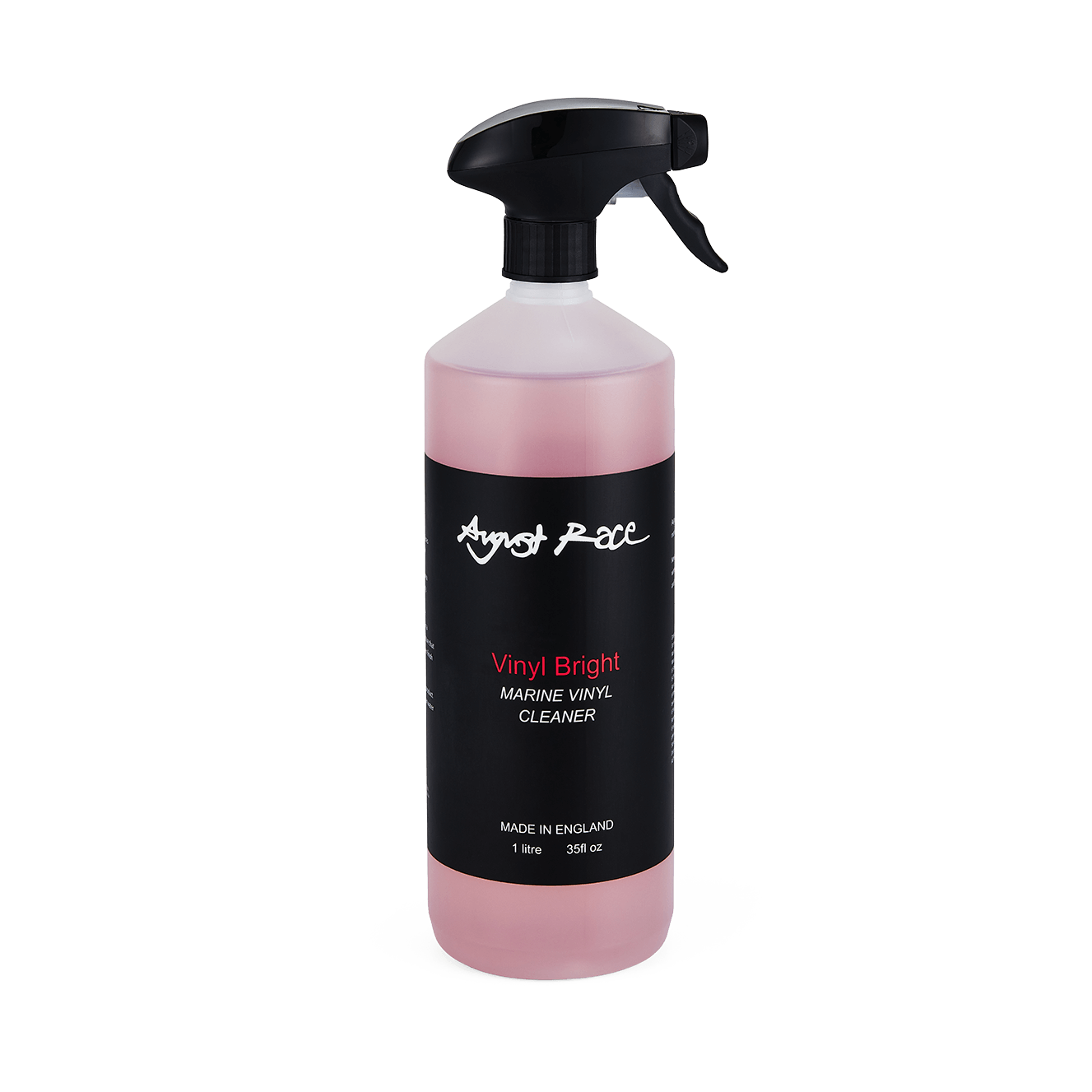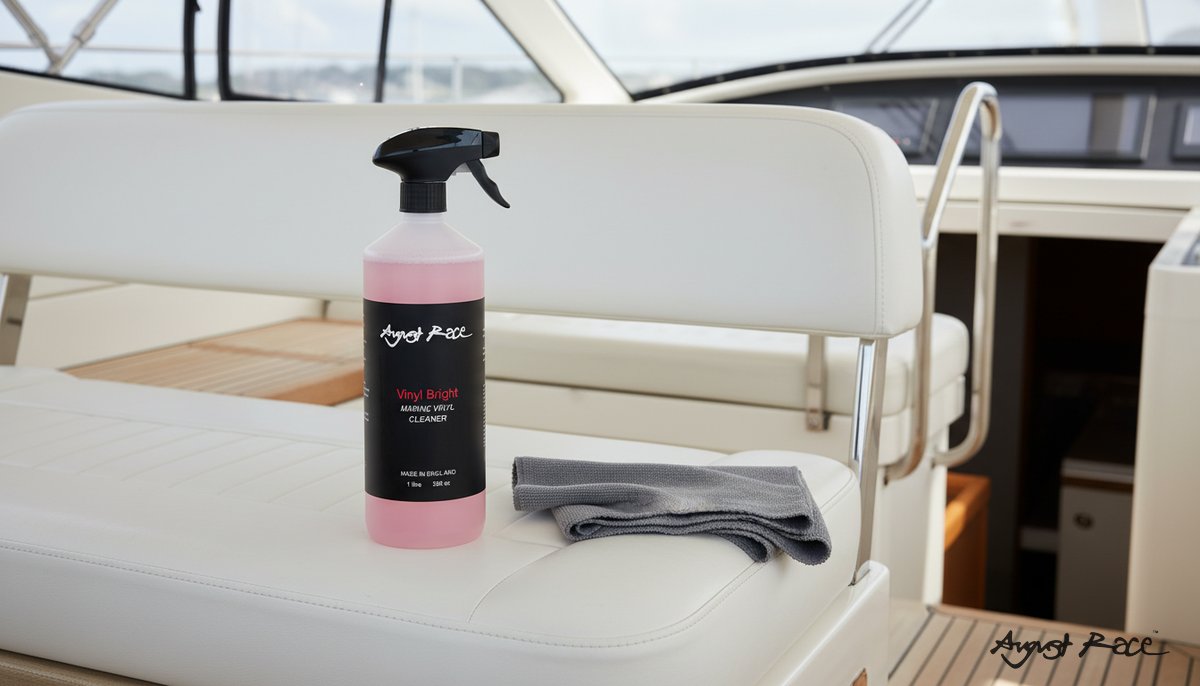Marine Vinyl Cleaning That Works: Using August Race Vinyl Bright for Pink Stains and Mildew
I got the call just after sunrise -- 10-year-old express cruiser, guests coming for a weekend run, and the cockpit cushions told the story before I even stepped aboard. The air had that sweet-sour note of damp foam and early mildew, and the white-to-light gray marine vinyl showed blotchy salmon-pink arcs along the seams with dark speckling near the quarter berth. This is classic marine vinyl cleaning territory: some contamination on the surface, some embedded.
Under angled light, I could see a sheen in the grain valleys -- biofilm -- while the pink staining hugged stitching paths and low spots. Wipe a finger, you get slickness but not full transfer, meaning a mix of surface residue and subsurface discoloration. Left alone, it’s not just ugly. Wet cushions get slippery, and unchecked growth plus UV can accelerate topcoat breakdown and plasticizer loss, shortening upholstery life.
The first decision isn’t which brush to grab -- it’s diagnosing what kind of stain you’re dealing with. That call determines chemistry, dwell time, and whether a non-abrasive vinyl cleaner like August Race Vinyl Bright cleaner is the right tool for pink stain removal and early mildew.
Diagnosing stains and mildew: what a marine tech checks first
Before you reach for a bottle labeled mildew remover vinyl, run a quick diagnostic. A few minutes here prevents coating damage and wasted effort.
- Visual assessment: Are stains clustered at seams and low points? Pink arcs often track moisture pathways; dark specks suggest surface biofilm. Uniform gray shadowing can be dye transfer from covers or clothing.
- Smell test: A musty note indicates fungal/biofilm presence. Sharp solvent or dye odors point to transfer or chemical interaction.
- Solvent/water swab: Lightly swab with plain water, then a mild isopropyl swab on a discrete area. If dye lifts to the pad, you’re dealing with transfer, not growth.
- Substrate flex test: Gently flex the vinyl. If discoloration “cracks” or shifts, it’s mostly surface contamination. If it stays uniform, staining may be within the topcoat or into the PVC face.
From a microbiology standpoint, “mildew” on vinyl is fungal and bacterial biofilm anchored in soil and body oils. Pink stains are frequently associated with bacteria like Serratia species, whose pigments can migrate into pores and stitching paths. Dye transfer is simply external pigment lodged in the topcoat grain.
Cleaner choice must respect the material stack: PVC face, factory-applied urethane or acrylic topcoat, and seam adhesives beneath. Aggressive solvents can extract plasticizers, causing stiffening or tack. High-pH or strong oxidizers can cloud topcoats. The goal is safe mold removal for boat vinyl without compromising coatings.
What to look for in a cleaner: non-abrasive chemistry and compatibility
For marine vinyl, chemistry does the work, not grit. Here’s the technical checklist I use to preserve marine upholstery vinyl while getting results:
- pH range: Aim for balanced formulations that loosen biofilm without etching or saponifying the topcoat binders. Extreme pH can haze coatings or soften seams.
- Surfactant system: Mixed non-ionic/anionic surfactants help lift body oils and environmental grime from the grain without leaving heavy residues that attract soil.
- Solvent limits: Avoid strong aromatic or high-VOC solvents that extract plasticizers. Water-based systems with controlled solvency are safer for PVC and adhesives.
- Chelating agents: Helpful for breaking mineral bonds in dock rash or dried spray, improving rinse-off and reducing film.
- Oxidation approach: For stain removal, prefer approaches that target organic pigments without the collateral damage of harsh bleach or strong acids on vinyl.
- Non-abrasive: No solids that scratch. Abrasives scuff the topcoat, inviting UV damage and faster re-soiling.
Non-abrasive matters because the factory topcoat is your UV shield and soil barrier. Micro-scratches behave like open doors for contaminants and accelerate gloss loss. Once the topcoat is compromised, even the best cleaner can’t restore tensile performance.
Compatibility testing is mandatory:
- Patch-test a hidden corner.
- Note dwell time and observe for whitening, softening, or tack.
- Rinse thoroughly and reassess under angled light.
Tie it all to maintenance outcomes. A compatible cleaner helps maintain seam adhesive integrity, keeps the topcoat intact, and extends service intervals. That’s how you preserve marine upholstery vinyl and avoid premature reupholstery.
With those criteria set, here’s why August Race Vinyl Bright cleaner is a strong fit for professional workflows.
Why August Race Vinyl Bright fits the bill: formulation & performance
August Race marine vinyl upholstery cleaner is designed specifically for marine vinyl cleaning with a non-abrasive, water-based approach. In field use, technicians value its surfactant-driven lift to break biofilm and loosen discoloration in the grain without resorting to aggressive abrasives or harsh acids. It’s a reliable mildew remover vinyl solution for early-stage growth when you want to keep coatings intact.
The product is straightforward to deploy: apply, allow a controlled dwell, agitate with a soft brush, and rinse clean. Technicians favor this kind of balanced chemistry because it focuses on contaminant removal rather than attacking the vinyl itself. Recommended contact times -- kept within typical upholstery-safe windows confirmed by patch tests -- help address pink staining and mildew residue while respecting PVC and topcoats.
Compatibility in the real world matters. Vinyl Bright is used on:
- Marine vinyl upholstery and vinyl-backed cushions
- Adjacent gelcoat and plastic trim (rinse overspray)
- Marine-grade plastics and carpet transitions
Use standard caution around clear isinglass, raw anodized metals, and any repainted or coated surfaces -- patch test and rinse promptly.
Performance expectations, based on technician practice:
- Biofilm and light mildew residue visibly release after a short dwell and light agitation.
- Pink staining typically lightens on the first pass; stubborn areas may need multiple short cycles rather than one long soak.
- Thorough rinsing leaves a clean surface that accepts marine UV protectants well, supporting long-term upkeep routines.
Next up is the exact, field-proven protocol I use to remove pink stains on boat seats and mildew while protecting the upholstery.
Step-by-step protocol: safe removal of pink stains and mildew with Vinyl Bright
Follow this process when you need to remove pink stains on boat seats and tackle early mildew without risking the topcoat. It’s the same approach I teach to new techs looking for the best cleaner for marine vinyl mildew while keeping materials safe.
Pre-job prep
- PPE: Nitrile gloves, eye protection, and a light mask in enclosed spaces.
- Ventilation: Open hatches and run fans in cabins to reduce vapor buildup.
- Tools and materials: August Race marine vinyl upholstery cleaner, soft nylon detailing brush, microfiber towels, applicator bottle, fresh water supply, small syringes or swabs for seam work, and a headlamp or inspection light.
Patch test (do not skip)
-
Choose a discreet area under a cushion flap or aft corner.
-
Apply a small amount of Vinyl Bright and note the time.
-
Allow 10–15 minutes while observing for whitening, softening, or tack. Gently wipe and rinse.
-
If the surface looks normal when dry, proceed. If you see coating clouding or stickiness, shorten dwell, dilute if directed on label, or reconsider chemistry.
Application technique
-
Dry remove loose debris with a vacuum or dry towel.
-
Lightly mist Vinyl Bright onto the target area. Avoid flooding foam-backed cushions; over-saturation can drive contaminants deeper.
-
Allow a controlled dwell. Keep the surface uniformly damp, not dripping.
-
Agitate with a soft nylon brush using strokes parallel to the vinyl grain and along seams. This reduces topcoat shear.
-
For seam lines and creases, use a swab or soft detailing brush, working away from stitching to avoid driving soil into threads.
Rinse and neutralize
-
Rinse thoroughly with fresh water. A low-pressure spray or damp microfiber works for cabins.
-
Blot, don’t rub, to lift remaining residues without opening the grain.
-
Inspect under angled light. If pink shading remains, repeat short cycles rather than extending dwell excessively.
Post-treatment preservation
- After surfaces are fully dry, apply a marine-grade UV protectant/conditioner compatible with vinyl upholstery.
- Inspect seams for early adhesive failure or loose stitching.
- Set maintenance intervals: light-use boats may need quarterly touch-ups; humid, covered slips often need monthly checks with quick wipe-downs after wet trips.
Pro tips
- Work in sections so dwell is controlled.
- Keep clean and dirty towels separate to avoid re-depositing soil.
- Document patch-test times and observations in your job log.
Field data and technician reports: efficacy, safety, and longevity
From service logs and bench reports, a few patterns show up when Vinyl Bright is used with the protocol above.
Efficacy
- Light pink staining and early mildew usually clear with a single short dwell and agitation cycle.
- Heavier, older pink stains respond to multiple short cycles. Good ventilation and post-clean drying reduce recurrence.
Material safety
- Patch-tested areas show no topcoat clouding when dwell is controlled and rinsing is thorough.
- After rinsing and drying, surfaces feel normal -- not tacky -- indicating plasticizers aren’t being pulled to the surface.
- Seams remain stable when avoiding soak-through; blotting and controlled application are key.
Longevity
- Boats in high-humidity marinas benefit from monthly light clean-and-dry routines, saving deep cleans for quarterly or seasonal turns.
- If vinyl shows persistent discoloration that won’t shift after multiple careful cycles and the topcoat is visibly worn, it’s time to discuss reupholstery rather than escalating chemistry.
Practical considerations, safety notes, and troubleshooting
Safety first for safe mold removal for boat vinyl:
- PPE: Gloves and eye protection are standard. Use masks in poorly ventilated cabins.
- Electrical safety: Keep liquids away from outlets and panels; cover with plastic as needed.
- Open seams: Avoid forcing liquid into open stitching or failed seams. Treat from the surface and blot.
Troubleshooting
- Stain persists: Repeat short cycles with controlled dwell. Don’t lengthen dwell beyond your patch-tested window.
- Dye transfer: If a solvent swab shows color transfer, treat as dye, not mildew. Clean gently and consider a specialty dye remover after testing.
- Oxidized/yellowing: That’s UV/topcoat aging, not soil. Cleaning won’t reverse oxidation; protect and plan for re-trim if structural.
Environmental and disposal
- In regulated marinas, capture rinsate when practical and dispose per local rules.
- Store concentrates securely and carry a small spill kit -- absorbent pads and a labeled waste bag -- on the service cart.
Keep your fleet clean: stock, train, and document -- next steps for techs
Reliable marine vinyl cleaning is about consistency, not heroics. Stock August Race Vinyl Bright cleaner on service vans and in boat club supply rooms, and standardize how it’s used.
Minimal training checklist
- Patch-test procedure and dwell control
- Brush selection and stroke technique
- Rinsing and blotting protocol to protect seams and foam
- Post-clean UV protection and documentation
Documentation habits
- Before/after photos under consistent light
- Patch-test log with times and observations
- Maintenance interval notes and any seam or topcoat concerns
Ready to standardize your process?
- Order a sample and download the checklist: Trial August Race Vinyl Bright cleaner on one boat, record the process, and align your team on the protocol. You can also browse the full range at the August Race shop.
As technicians, we’re responsible for passenger safety and asset longevity. Choosing a non-abrasive vinyl cleaner and a disciplined process keeps cushions safe, clean, and service-ready season after season.
FAQ: quick answers from the tech bench
Below are concise answers to the most common questions I get about how to remove pink stains on boat seats and selecting the best cleaner for marine vinyl mildew. Always patch-test, control dwell time, and escalate to reupholstery only when cleaning can’t recover a worn topcoat. For complex cases, review the product SDS and contact technical support for guidance.
What is the best cleaner for marine vinyl mildew and is Vinyl Bright safe for all vinyl types?
Look for a non-abrasive, water-based cleaner formulated for marine vinyl; August Race Vinyl Bright fits that profile and is widely used by technicians. Always patch-test because vinyl formulations and topcoats vary by manufacturer and age, and adjust dwell time based on the test result.
How do I remove pink stains on boat seats without damaging the topcoat?
Patch-test a hidden area, then apply Vinyl Bright in controlled, short dwell cycles with soft-brush agitation parallel to the grain. Rinse thoroughly and blot dry between cycles; repeat as needed rather than extending dwell beyond your safe window.
What safety steps should technicians take when performing mold or mildew removal on boat vinyl?
Wear nitrile gloves and eye protection, and ensure ventilation in enclosed cabins; protect electrical panels from overspray. Avoid saturating foam-backed cushions or open seams, and capture rinsate where required by marina regulations.
About the Author
August Race Team
The August Race professional team brings decades of marine industry expertise and product development knowledge.
Get Expert Tips
Subscribe for marine care insights and product updates from industry professionals.
No spam. Unsubscribe anytime.
You May Also Like

Professional Gelcoat Restoration vs DIY: Clear Winner
Achieve a flawless boat! Explore expert gelcoat restoration, marine cleaning, and rust removal tips. Learn if DIY or professional is your clear winner.

August Race Vinyl Bright: Safe, Marine-Safe Vinyl Cleaner
Use August Race Vinyl Bright, a safe, non-abrasive, marine-safe vinyl cleaner to protect boat seats, maintain vinyl integrity, and prevent fading.

Vinyl Bright by August Race — Non‑Abrasive Power for Marine Vinyl Mildew
Non-abrasive marine vinyl cleaner that removes mildew and mold fast while preserving color, texture, and feel of boat upholstery.
